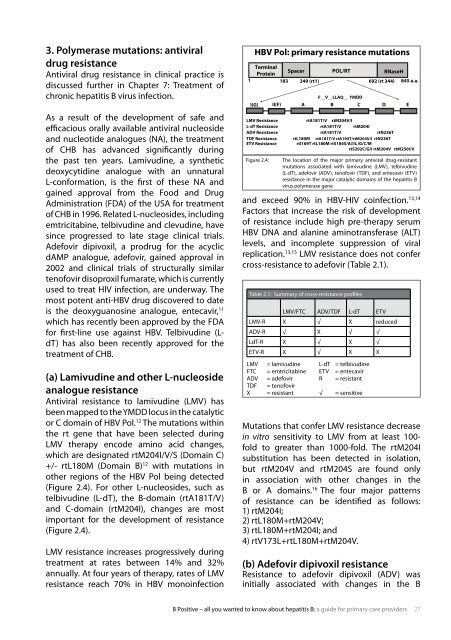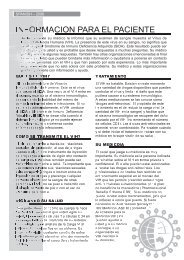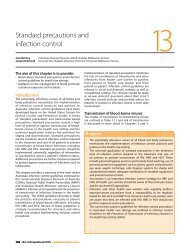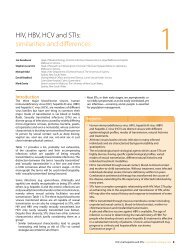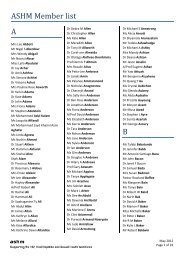B Positive – all you wanted to know about - ASHM
B Positive – all you wanted to know about - ASHM
B Positive – all you wanted to know about - ASHM
Create successful ePaper yourself
Turn your PDF publications into a flip-book with our unique Google optimized e-Paper software.
3. Polymerase mutations: antiviral<br />
drug resistance<br />
antiviral drug resistance in clinical practice is<br />
discussed further in chapter 7: treatment of<br />
chronic hepatitis b virus infection.<br />
as a result of the development of safe and<br />
efficacious or<strong>all</strong>y available antiviral nucleoside<br />
and nucleotide analogues (na), the treatment<br />
of cHb has advanced significantly during<br />
the past ten years. Lamivudine, a synthetic<br />
deoxycytidine analogue with an unnatural<br />
L-conformation, is the first of these na and<br />
gained approval from the food and drug<br />
administration (fda) of the usa for treatment<br />
of cHb in 1996. related L-nucleosides, including<br />
emtricitabine, telbivudine and clevudine, have<br />
since progressed <strong>to</strong> late stage clinical trials.<br />
adefovir dipivoxil, a prodrug for the acyclic<br />
daMP analogue, adefovir, gained approval in<br />
2002 and clinical trials of structur<strong>all</strong>y similar<br />
tenofovir disoproxil fumarate, which is currently<br />
used <strong>to</strong> treat HiV infection, are underway. the<br />
most potent anti-HbV drug discovered <strong>to</strong> date<br />
is the deoxyguanosine analogue, entecavir, 11<br />
which has recently been approved by the fda<br />
for first-line use against HbV. telbivudine (Ldt)<br />
has also been recently approved for the<br />
treatment of cHb.<br />
(a) Lamivudine and other L-nucleoside<br />
analogue resistance<br />
antiviral resistance <strong>to</strong> lamivudine (LMV) has<br />
been mapped <strong>to</strong> the yMdd locus in the catalytic<br />
or c domain of HbV Pol. 12 the mutations within<br />
the rt gene that have been selected during<br />
LMV therapy encode amino acid changes,<br />
which are designated rtM204i/V/s (domain c)<br />
+/- rtL180M (domain b) 12 with mutations in<br />
other regions of the HbV Pol being detected<br />
(figure 2.4). for other L-nucleosides, such as<br />
telbivudine (L-dt), the b-domain (rta181t/V)<br />
and c-domain (rtM204i), changes are most<br />
important for the development of resistance<br />
(figure 2.4).<br />
LMV resistance increases progressively during<br />
treatment at rates between 14% and 32%<br />
annu<strong>all</strong>y. at four years of therapy, rates of LMV<br />
resistance reach 70% in HbV monoinfection<br />
Figure 2.4<br />
HBV Pol: primary resistance mutations<br />
Terminal<br />
Protein<br />
Spacer POL/RT RNaseH<br />
1 183 349 (rt1) 692 (rt 344) 845 a.a.<br />
I(G) II(F)<br />
F__V__LLAQ__ YMDD<br />
A B C D<br />
E<br />
LMV Resistance rtA181T/V rtM204V/I<br />
L-dT Resistance rtA181T/V rtM204I<br />
ADV Resistance rtA181T/V rtN236T<br />
TDF Resistance rtL180M rtA181T/V rtA194T/rtM204V/I rtN236T<br />
ETV Resistance rtI169T rtL180M rtS184S/A/I/L/G/C/M<br />
rtS202C/G/I rtM204V rtM250I/V<br />
figure 2.4: the location of the major primary antiviral drug-resistant<br />
mutations associated with lamivudine (LMV), telbivudine<br />
(L-dt), adefovir (adV), tenofovir (tdf), and entecavir (etV)<br />
resistance in the major catalytic domains of the hepatitis b<br />
virus polymerase gene<br />
and exceed 90% in HbV-HiV coinfection. 13,14<br />
fac<strong>to</strong>rs that increase the risk of development<br />
of resistance include high pre-therapy serum<br />
HbV dna and alanine aminotransferase (aLt)<br />
levels, and incomplete suppression of viral<br />
replication. 13,15 LMV resistance does not confer<br />
cross-resistance <strong>to</strong> adefovir (table 2.1).<br />
table 2.1: summary of cross-resistance profiles<br />
LMV/ftc adV/tdf L-dt etV<br />
LMV-r X √ X reduced<br />
adV-r √ X √ √<br />
Ldt-r X √ X √<br />
etV-r X √ X X<br />
LMV = lamivudine L-dt = telbivudine<br />
ftc = emtricitabine etV = entecavir<br />
adV = adefovir r = resistant<br />
tdf = tenofovir<br />
X = resistant √ = sensitive<br />
Mutations that confer LMV resistance decrease<br />
in vitro sensitivity <strong>to</strong> LMV from at least 100fold<br />
<strong>to</strong> greater than 1000-fold. the rtM204i<br />
substitution has been detected in isolation,<br />
but rtM204V and rtM204s are found only<br />
in association with other changes in the<br />
b or a domains. 16 the four major patterns<br />
of resistance can be identified as follows:<br />
1) rtM204i;<br />
2) rtL180M+rtM204V;<br />
3) rtL180M+rtM204i; and<br />
4) rtV173L+rtL180M+rtM204V.<br />
(b) Adefovir dipivoxil resistance<br />
resistance <strong>to</strong> adefovir dipivoxil (adV) was<br />
initi<strong>all</strong>y associated with changes in the b<br />
b <strong>Positive</strong> <strong>–</strong> <strong>all</strong> <strong>you</strong> <strong>wanted</strong> <strong>to</strong> <strong>know</strong> <strong>about</strong> hepatitis b: a guide for primary care providers 7


